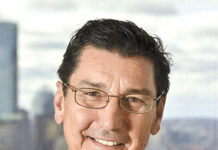By Christina Hennessy
FAIRFIELD, Conn. —
Lacy Birdseye has just entered the next phase of her health care career after graduating from Fairfield University’s master’s program in nursing. For three years, this Fairfield, Conn., resident has worked to become a family nurse practitioner.
Birdseye, 33, hopes to work in a community health center, a place that likely will serve people of all ages, from babies to seniors. “It is all about taking care of a person as a whole,” she said.
When it comes to serving patients in the next 20 years, that holistic approach — looking at all components of a person’s social, emotional and physical well-being — will increasingly serve an aging population, a shift that has not gone unnoticed by Birdseye and those who are preparing the next generation of health care providers.
By 2030, the number of people in the United States who will be 65 and older is expected to be 72 million, up from 35 million in 2000, according to the government report, Older Americans 2010: Key Indicators of Well-Being. That surge is being driven by the baby boomers, who represent those born from 1946 to 1964. Boomers begin turning 65 this year.
For those 85 and older, a century has made all the difference. That population, which numbered just over 100,000 in 1900 grew to 5.7 million by 2008.
“When I started in gerontology, it was in its infancy,” said Joan Dacher, an associate professor in the nursing department at the School of Health Sciences at The Sage Colleges, with campuses in Troy and Albany, N.Y. “In the 1980s, it was really coming into its own as a sub-specialty in health care.”
Dacher said gerontology focuses on the science of growing older — the social, financial, psychological, physical aspects — rather than solely concentrating on diseases and conditions that may affect an aging population.
“That old … rocking-chair existence has gone out the window,” said Dacher, who is a boomer herself. “More adults do need to return to the workforce to keep themselves afloat. And, boomers see aging as a completely active time.”
Cultural changes and medical innovations have helped to create this shift, said many of those interviewed. They include the 1965 passage of the government health insurance program Medicare, advancements in technology, increased use of pharmaceuticals, greater attention to healthier lifestyles and a greater expectation that their retirement years will be active ones.
This is the world Birdseye and the graduates after her will enter. Given that reality, nursing schools have made efforts to make sure curriculum has followed suit.
For instance, Fairfield University’s School of Nursing recently acquired some new simulation dummies and other devices for its PRACTICE Geriatric Nursing Simulated Clinic, with a $233,153 grant from the Department of Health and Human Services. The dummies can be programmed to evidence signs and symptoms of conditions associated with aging, such as Alzheimer’s disease, heart disease, metabolic syndrome, Parkinson’s disease and others.
On a recent day, students came in to “find” a 90-year-old woman with pneumonia and flu symptoms, said Suzanne Campbell, School of Nursing associate dean for academics programs.
“We can make them breathe. We can adjust their heart rates. We can even make them sweat,” Campbell said. “And the students know nothing until they walk in the classroom, just as it would be in real life.”
Birdseye agreed. “It was a great learning experience,” she said. “It brings in the idea of a real-life situation. It’s a good way to see what you are capable of and what you may have missed.”
And, in the elderly, there can be many conditions present said Glenda Kelman, the chair of Sage’s nursing department. “In addition to diabetes, they have had bypass and open-heart surgery not once, but maybe twice. And they have had their hip replaced and may be on many medications,” she said.
Clinical outreach programs, during which students work with aging and elderly patients, help to change perspectives, Kelman said. “I think it does open the students’ eyes to individually assessing an individual’s quality of life and functional ability,” she said.
She offered as an example a student who goes to a hospital to check up on an 85-year-old woman whose medical history includes hip surgery, a heart attack and diabetes.
“They will come back and say, ‘I asked her how she was and she said she was feeling pretty good. She said she plans to go on vacation when she gets out of hospital,’ ” Kelman said.
Many of those interviewed said the New York City-based John A. Hartford Foundation, which last year celebrated the 10th anniversary of its Building Academic Geriatric Nursing Capacity initiative, had a significant impact on shifting the focus toward geriatric care. That effort, which included the support of millions of foundation dollars, worked to identify strategies that would improve geriatric nursing care, such as integrating geriatrics into the curriculum and establishing academic centers.
“There has been recognition on the part of schools for many, many years that the population is aging. And, there needs to be more people who understand the needs of an aging population,” said M. Brownell Anderson, senior director for educational affairs at the Washington, D.C.-based Association of American Medical Colleges. “Students coming in are recognizing that they are going to be practicing a new kind of medicine.”
It may be a large-scale issue, but caring for an aging population still remains a one-on-one experience between patient and provider, Birdseye said. It can involve talking about care that can be afforded, explaining prescriptions and instructions, looking for signs of depression or anxiety or compensating for reduced mobility. It is about keeping a person as healthy and mobile as he or she can be, Birdseye said.
“I want to empower people … so they can best enjoy their life.” — AP











